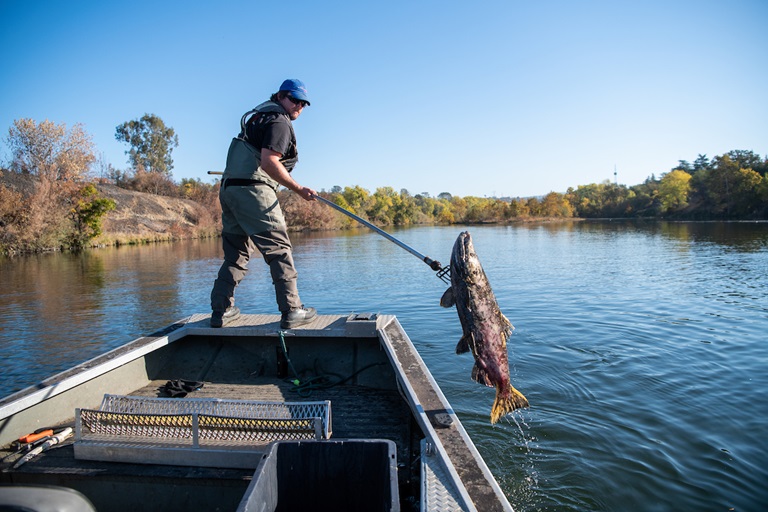'Carcass Survey' Helps DWR Learn About Health of Salmon Species
Image of salmon carcass survey in the Feather River in Oroville, DWR/2020
After salmon spawn, or reproduce, it marks the end of their lifecycle. For the Department of Water Resources (DWR) it marks an important time for dissecting and studying salmon carcasses to learn about the species’ population and assess their numbers in the Feather River.
“We do our Chinook Salmon Escapement Survey, also known as a ‘carcass survey’, to determine how many salmon are coming back to the river to spawn on any given year,” said Casey Campos, DWR environmental scientist. “These numbers are really important in estimating how many fish are still in the ocean and available for next year's commercial and recreational fisheries.”
Born in freshwater streams and rivers, juvenile salmon migrate to the ocean where they spend a large part of their lives. After growing in the ocean for a year or more, the adults return to the rivers where they were born to reproduce, and then die.
For 16 weeks starting in September, DWR biologist survey the upper Feather River, from downtown Oroville to Gridley to find dead salmon. Teams of biologists troll 16 miles of river every week looking for salmon carcasses to study. When they encounter a salmon carcass that looks as though it has been decomposing longer than a few days, they cut it in half, so they don’t accidently recount it on subsequent trips. If they find a freshly dead carcass, they tag it for use in a “mark-recapture experiment.”
“We put the tagged fish back into the river, when we come back in subsequent weeks, we will then be able to recapture them,” Campos said.
The rate at which tagged carcasses are re-captured is used to give DWR an estimate on how many salmon are returning to the Feather River to spawn.
“Imagine if we mark 1,000 salmon carcasses for the mark-recapture during our initial survey trip, and only find 500 on the next,” Campos said. “That means we are probably only seeing half of the salmon that are really returning to spawn.”
DWR also gathers samples from the salmon carcasses, such as otoliths – ear bones – and scales.
If they find a carcass with a clipped adipose fin (small fin on their back near the tail), it means the salmon was born in the Feather River Fish Hatchery. Scientists take the head of the hatchery salmon to recover a coded wire tag that was implanted in their snout when they were a juvenile and not yet released into the wild. Coded wire tags allow DWR to assess the survival and stray rates of different release groups of hatchery fish.
The DWR carcass survey is an important step in finding out how many Chinook salmon are using the Feather River to spawn. The Feather River contributes about 20 to 25 percent of salmon production - most being fall-run Chinook.
Water from the Feather River is diverted to the Central Valley, the south bay, and Southern California through the State Water Project (SWP). The Feather River Fish Hatchery is a SWP facility built in the late 1960s to mitigate impacts on fish migration resulting from the construction of Oroville Dam.
“DWR has quite a stringent task of maintaining healthy environments and providing water for a large majority of the state of California,” Campos said. “This survey is important in letting us know that we're able to do both successfully.”
Visit our Q&A page with Casey Campos to learn more about the DWR carcass survey and what it’s like to be an environmental scientist.
Visit our Pixel Gallery to view more photos of the 2020 fall carcass survey.
